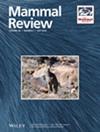大西洋森林灵长类动物和它们的主要食物来源
IF 4.4
2区 生物学
Q1 ECOLOGY
引用次数: 0
摘要
灵长类是树栖和半树栖物种,高度依赖维管植物。灵长类动物的饮食通常包括植物部分,如水果和叶子。对于这个受到高度威胁的群体来说,尤其是在森林被砍伐和支离破碎的大西洋森林中,了解消费最多的物品是至关重要的。我们的目的是综合大西洋森林灵长类动物的食物资源知识。研究了这些研究的时空分布,包括饮食信息、记录为食物资源的主要分类群以及这些灵长类动物最常食用的植物部分。我们在Web of Science中检索了包含灵长类动物食物资源记录的已发表文献,并筛选了Neotropical primates卷。96%的食物记录来自植物,主要是水果(50%)、叶子(31%)和花(14%)。大多数植物种、属、科几乎没有记录。记录最多的科为桃金娘科(n = 440)和豆科(n = 392),属为Eugenia (n = 123)、Inga (n = 113)、Ficus (n = 109)和Myrcia (n = 102)。一些有长期保护计划或种群监测的灵长类物种有最多的食物资源记录。研究地点通常只覆盖灵长类物种地理范围的一小部分,表明地理偏差。我们的发现突出了大西洋森林灵长类动物饮食研究的缺乏,特别是对濒危物种,如Callithrix aurita和Leontopithecus caissara,只有自然历史记录的食物资源,以及Sapajus robustus,没有记录。考虑到灵长类动物饮食的关键植物物种,这里综合的信息可以用于规划和执行更有效的大西洋森林恢复计划。我们强调有必要对大西洋森林灵长类动物的饮食进行更多的研究,因为这些知识有助于理解生物体的可塑性和生理学。本文章由计算机程序翻译,如有差异,请以英文原文为准。

Atlantic Forest primates and their main food resources
- Primates are arboreal and semi-arboreal species, highly dependent on vascular plants. Primate diets typically include plant parts, such as fruits and leaves. Knowledge of the most consumed items is essential for this highly threatened group, especially in the deforested and fragmented Atlantic Forest.
- Our aim was to synthesise the knowledge about food resources of Atlantic Forest primates. We investigated the temporal and spatial distribution of studies with information on diet, the main taxa recorded as food resources, and the parts of plants most consumed by these primates.
- We searched for published literature containing food resource records for primates in the Web of Science and screened Neotropical Primates volumes.
- 96% of the food records were from plants, mainly fruits (50%), leaves (31%) and flowers (14%). Most plant species, genera and families have few records. The families most recorded were Myrtaceae (n = 440) and Fabaceae (n = 392), and the genera were Eugenia (n = 123), Inga (n = 113), Ficus (n = 109) and Myrcia (n = 102). A few primate species with long-standing conservation programs or population monitoring had the highest number of food resource records. Study sites generally cover only a small part of the geographic range of the primate species, indicating a geographic bias.
- Our findings highlight the scarcity of research on the Atlantic Forest primate diet, which is especially concerning for threatened species such as Callithrix aurita and Leontopithecus caissara, which only had natural history notes on food resources, and Sapajus robustus, which had no records.
- The information synthesised here can be useful for planning and executing more efficient Atlantic Forest restoration plans, considering the key plant species for the primate diet. We reinforce the need to conduct more research on the diets of Atlantic Forest primates, as this knowledge can contribute to the understanding of the plasticity and physiology of organisms.
求助全文
通过发布文献求助,成功后即可免费获取论文全文。
去求助
来源期刊

Mammal Review
生物-动物学
CiteScore
12.20
自引率
4.10%
发文量
29
审稿时长
>12 weeks
期刊介绍:
Mammal Review is the official scientific periodical of the Mammal Society, and covers all aspects of mammalian biology and ecology, including behavioural ecology, biogeography, conservation, ecology, ethology, evolution, genetics, human ecology, management, morphology, and taxonomy. We publish Reviews drawing together information from various sources in the public domain for a new synthesis or analysis of mammalian biology; Predictive Reviews using quantitative models to provide insights into mammalian biology; Perspectives presenting original views on any aspect of mammalian biology; Comments in response to papers published in Mammal Review; and Short Communications describing new findings or methods in mammalian biology.
 求助内容:
求助内容: 应助结果提醒方式:
应助结果提醒方式:


